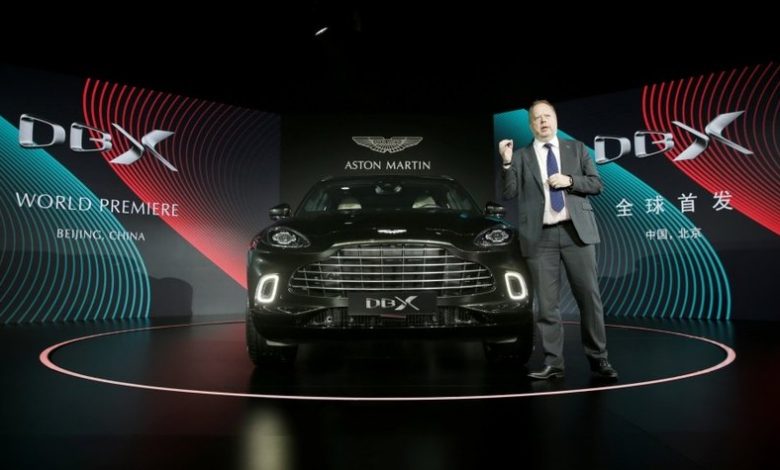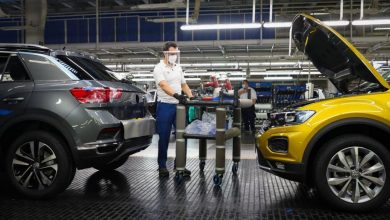
Aston Martin CEO counts on first SUV to return brand to profit
Every car we launch is important because of the way the business runs. But in terms of changing the company so that we address each of the luxury clusters, this is really important. So far, we have replaced the core GT and sports cars — our historical ground. This is the first model that expands the portfolio.
How many can you sell in a full year?
I can’t give forward-looking data but we are about 6,000 to 6,500 units this year. We will not have a full year of DBX but we’ve more sport cars coming: the Vantage roadster arrives next year, and the mid-engine car [the Vanquish, comes in 2021]. The DBX will represent the largest-single volume.
Today more than 70 percent of Aston Martin customers have an SUV in the garage, so the hard work is already done. We just need to convert those people from their daily driver into an Aston Martin SUV. They are coming out of Porsche Cayennes and Range Rovers. What we are looking to do is cream off the top of that premium SUV sector. The Cayenne has been an important benchmark in the development of the car. Our cars don’t compete directly, but they [Porsche] are a very credible source when it comes to ride and handling, and build quality.
MEET THE BOSS
NAME: Andy Palmer
TITLE: Aston Martin President and CEO
AGE: 56
MAIN CHALLENGE: Delivering Aston Martin’s first SUV on time and to standards exceeding those of rivals already on the market.
The reveal was in Beijing and Los Angeles. Why those two places?
China and the U.S. are the car’s biggest markets, but also it’s a signal that we are a very traditional British car company trying to be more global in our approach. The DBX has, in particular, been very much designed with Chinese and American customers in mind.
The DBX will be V-8 gasoline only at a time when SUVs have come under attack from environmental activists. Will this affect demand?
The whole industry is under the spotlight in terms of CO2 so obviously it’s important to make increasingly efficient SUVs. Do I think there’s a wholesale change from SUVs back to another type of vehicle? I don’t see it at the moment. If you look at the startup EV makers they are all basically starting with SUVs. If you look around the world, the SUV is the preferred body type.
Aston’s first hybrids will be versions of the Valkyrie and V6 Valhalla hypercars. How quickly will the SUV get a hybrid variant?
We are not yet disclosing our cadence of hybrid rollouts, but by the middle of the 2020s all of our cars will have a hybrid offering.
Will they be plug-in or full hybrids?
We are looking at both. I’m not a big fan of the plug-in hybrid because you are adding weight and complexity. My preferred delivery is a self-charging hybrid. The only reason for thinking otherwise is the definition of regulations and getting the CO2 credit and in some places that might push us to add a plug-in.
Some analysts, notably Max Warburton of Bernstein, are skeptical about the roll out of the Lagonda luxury electric brand by 2023. Is that still the plan?
We still work from that basis. Max’s commentary is that it’s a lot to do, and I would be first to acknowledge that, but we have also achieved a lot. When we announced the Second Century plan there were plenty of people speculating whether we had the capability to do everything we said, but I think we have already exceeded some of those people’s expectations. The most difficult car we did was the DB11 because it was essentially a new factory, new electrical architecture, new engine, new platform. Nothing that we will do will be as difficult as that. Moving into the SUV format with the DBX has also challenged us, but we have delivered everything on time so far.
You have reduced your vehicle sales guidance to 6,500 from 7,000 for 2019. Why?
Our sports cars are growing both in volume and in market share, but the Vantage market is difficult. It borders on premium and that market is more in line with automotive TIV [total industry volume].
The Vantage starts at about 125,000 pounds, which drags down your average selling price. Is it a market you need to be in?
What the Vantage allows us to do is to climb a ladder into luxury. None of the other luxury automakers provide that step, so you go from a high-end Porsche into the luxury arena. Vantage provides a platform to do that inside the brand. It’s also a platform on which we build our specials and our racecars, so we have creditability when we do stuff like Le Mans.
You have recently talked about actions to improve efficiencies and reduce costs. What actions have you taken?
The DBX is being developed much more efficiently than we anticipated and that impacts capital expenditure. When we drew the development costs curves we followed those we experienced with the DB11, but what we found is that we have been able to operate much more efficiently than in the past in terms of manpower spend or changes to tooling in the design. That has allowed us to reduce our forecast on capex by quite an extraordinary amount. In February, we gave a guidance of 320 to 340 million pounds, however, in July we revised it to 300 million pounds. The increase in virtual testing is a huge benefit. We operate in a lean environment where everyone is looking at places where it’s possible to eke out improvements.
The value of Aston Martin’s shares has fallen about 80 percent since the company went public in October 2018. Was the IPO a mistake?
Font: Automotive News Europe





